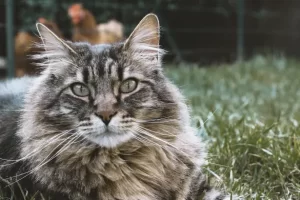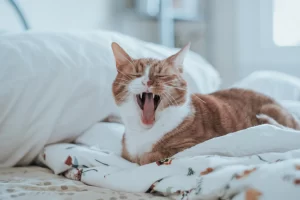Last updated on January 7th, 2023 at 07:59 pm

Why do cats arch their backs when you pet them? In most cases, they will only be able to convey their messages to one another through physical gestures and body language. Your cat may be trying to portray feelings of fear, delight, or even playfulness when they do things like arch their backs or get loose before engaging in an activity. That’s how they talk to you. In this case, when they arch their backs when you pet them, it usually means they are happy. Just like it arches its back when playing, your cat will utilize the same body language to indicate contentment that they are handled by humans. An arched back is frequently accompanied by purring in this scenario.
Both dogs and cats enjoy a good back stretch, but have you ever considered why cats seem to take more pleasure from it? You undoubtedly know that after a cat wakes up from a nap and starts brushing its paws, it will have its back arched. However, there are other scenarios in which you may notice your cat arching its back. Let’s discuss them in this article.
Why Do Cats Arch Their Backs?
Cats can’t talk so your cat uses their entire body to convey their feelings to you, one of those body languages is to arch their backs. Those who have observed their feline friend arching their back may wonder if this is a good sign or a bad sign. But do remember that it is normal.
There are a few possible meanings behind an arched cat’s back. Cats can use it to show you that they’re happy or to help their back to move into a more comfortable posture so that you can pet them or scratch their favorite spot. Your cat may also be arching its back to release tension in its spine and strengthen its shoulder muscles. There can be numerous reasons behind it.
However, you should remember one thing too; Scratching is soothing at first, but too much of it can be uncomfortable or even painful for your cat. When scratched on the lower back, cats react in different ways and have different pain thresholds than dogs. Veterinarian care may be necessary for cats that are overly sensitive to being handled in the back region. Cats that are in pain when touched in the back may be struggling due to damaged anal sacs, or cats that have any other condition. Let’s discuss the other reasons in detail. Here are some reasons why cats arch their backs when you pet them.
Your Cat is Afraid
This may be a tough one to accept especially if you own your cat since he/she is a kitten. Even if you are the owner, your cat can still be afraid of you sometimes. This also can happen when you pet a cat that is not yours, possibly a stray cat or another person’s cat. Here’s a quick way to know and rule out this reason. Take a quick look at these body languages.
The cat is huddled in a position where it is directly on top of its paws, and some sections of its body can be seen visibly shaking. Its tail is tucked in tight to its body, and it is able to stand upright, along with its hair, at the back of its head. This is the immediate response people have whenever they sense that they are in danger or whenever something makes them feel uneasy. They will immediately arch their backs, causing their hair to stand on edge, and often hiss at their opponent to tell them to back off. If you are the owner of a cat, then you have most likely witnessed this behavior at some point in the past.
In this position, the cat appears to be much more significant and frightening, and its purpose is to frighten away whatever is placing them in danger. In the vast majority of cases, your cat will be able to pursue them if they pose a moderate threat. This is a straightforward response to a potentially harmful circumstance. This person’s body language unequivocally conveys fear, followed by an instinct for self-defense.
Always remember these signs as this may indicate that your cat or other cats are going to hurt you and that they don’t want to be petted.
Your Cat is Being Playful
When cats arch backs, it can be a major warning sign, but it can also be seen when the cat is playing. When playing, this is a common thing for your cat to do. When you think about how offensive they are, this is nothing. This is different from a defensive stance because there are no bared teeth, growls, or hisses. Nothing more than laughable happiness. When the animal is really happy, like right before it jumps for a brightly colored toy, it may arch its back to show that it is really into the game.
When there is no hissing or snarling, an arched back shows that the animal is having fun. This pose, along with others like pouncing, running, and hopping shows that the animal likes the person, another cat, or a toy. But they only act this way around their favorite person, or playmate, or when they spot their prized ball. When they are like this, they may even jump all over the house. When a cat purrs when you walk up to it, it makes you feel great right away.
Stretching
Of course, stretching is the most common reason for why cats arch their backs. Stretching does not normally happen when you pet them unless you pet them after their nap. Cats are naturally more flexible than humans, which may initially surprise their owners when they see them stretching. However, cat owners quickly learn that their feline friends’ stretching habit is normal.
Having woken up from an extended snooze, felines, like humans, enjoy a good stretch. An ordinary cat stretch involves lying on its back with its tail raised and its paws wide apart. When your cat does this, it means they are tired and want to sleep. If you’ve been observant, you may have noticed that cats stretch in more than one way. The typical stretching position involves bending forward at the hips, dropping the head and chest, and lifting the tail off the ground.
The second stretch involves the back legs extending behind the animal while the front legs carry the animal’s weight. The classic image of a cat stretching involves the animal arching its back, generally in tandem with a yawn.
They Appreciate Your Gesture
Cat shows appreciation at you sometimes. After a long day of work, there’s nothing better than coming home to spend some quality time with the cat. Your cat probably has the same opinion, so why shouldn’t she show you that she supports what you’re doing by purring and showing other signs of approval?
It’s possible that you’ve just located one of your cat’s favorite spots, in which case you should proceed to pet it with your fingers or palm. In conclusion, cats are capable of pushing against the hand in order to make a polite request for additional pets and to show you that they have been delighted to see you and want to spend some time with you.
They Are Satisfied
You should expect this physical reaction from your cat if you give in to their persistent meowing for a scratch and give in to their demands. It shows that the scratch was executed properly, and it is a useful indicator. Because of this, they will arch their back, giving you easier access, to whatever is itching them. When a cat’s back is arched like this, it’s because it’s feeling relaxed and content in its current environment.
The most common and widespread sweet spots are as follows:
- At the level of the spine
- Located just under the jaw.
- Ahead of the curve.
- Back behind the ears
It’s important to be very careful and delicate while scratching or touching your cat. The most sensitive areas of a cat are the stomach and the base of the tail, and it’s impossible to know how any given cat would react to being petted there. Keep in mind there is a thin line between making your cat feel at ease and making them uncomfortable; if you cross that line, your cat may resort to biting or scratching you.
Should You Always Pet Your Cat?
The outcome will depend on your cat’s level of enjoyment throughout the procedure. A cat’s arched back is not necessarily a sign that it appreciates being petted. In any case, you should exercise extreme caution and observe how the cat responds to the message before continuing. A purring, slow blinking, nibbling cat is quite fine. As a result, it’s crucial that you learn to read your cat’s every gesture.
You must instantly stop whatever you’re doing if your cat starts crying, meowing, or showing other signs of anger. It is recommended that you try to reduce the amount of stimulation in the area, as was indicated previously, and that you experiment with different types of petting to see what your cat prefers.
My Cat Purrs or Meows While Arching Its Back
A contented feline will arch its back and meow or purr to show it. It’s the most common way for cats to express happiness. It’s not common for animals to make as much noise as cats do. A simple meow will explain everything you need to know about why your cat is arching its back.
The cat’s meowing and arched back are attempts to:
- Get your attention.
- Asking for food.
- Put out a distress signal.
- Extend greetings.
- Showing red signal.
When a cat meows while being petted, it could be expressing a variety of emotions, including joy, enthusiasm, or even a desire for attention or food. Cats rarely, if ever, meow at other animals. On the other hand, if your cat is meowing nonstop, it may be an indication that it is in some kind of discomfort or agony. It’s possible the cat is attempting to tell you something by attracting your attention.
The purring of a healthy cat is usually a good indicator. Back arches are a common way for cats to express happiness and contentment. That is especially the case while you are petting them. You can tell a cat is calm and relaxed if it isn’t flattening its ears, slinking around on the floor, or growling at anything.
Do Cats Like It When You Pet Them?
No. Certain cats are more sensitive than others to have their backs rubbed or patted, and the backs of some cats are even ticklish. Cats are often accepting of a wide variety of human behavior and environment. Some people love it when you scratch their head, while others would rather have their cheeks or ears scratched.
It’s likely that the only problem is that your cat just doesn’t like having its back handled. It’s true that some cats with urinary disorders, especially kidney disease, would rather not have their lower backs stroked or brushed. Of course, this particular group of cats is the outlier.
What Should I Do If I Notice That My Cat Has Its Back Arched?
It is not an indication of hostile behavior on the part of your cat if you see her arching her back and stretching. You can pet them all the way down the length of their spine and all the way up their tail, and they will most likely move closer to you and give you an enthusiastic head bump.
On the other hand, if you are walking down the street and a stray cat growls and arches its back at you, you should move away from it. Move away from the cat in a cautious manner while maintaining complete silence. It’s possible that an angry or fearful animal will attack if you make rapid motions and shout at it.
Conclusion
You now know the primary explanations for why cats arch their backs. While most cats would rather not have anyone pet them, there are a few exceptions. Look for the crucial signs and body language they use to communicate with you.
When you are first getting to know a cat or meeting one for the first time, it’s better to take things slow with love and affection until the cat is comfortable with you. Whenever your cat arches its back, pay close attention. They could be fearful, or they could be happy and friendly/playful. You shouldn’t further annoy your cat by touching it if it’s not comfortable with it.
Also read: Why Do Some Cats Not Like To Be Held?


